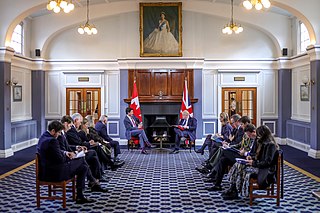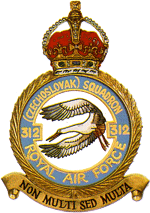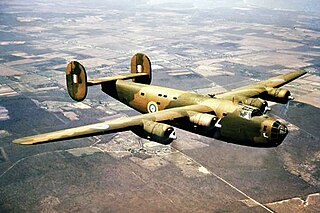
Royal Air Force Northolt or more simply RAF Northolt is a Royal Air Force station in South Ruislip, 2 nautical miles from Uxbridge in the London Borough of Hillingdon, western Greater London, England, approximately 6 mi (10 km) north of Heathrow Airport. As London VIP Airport, the station handles many private civil flights in addition to Air Force flights.

No. 310 Squadron RAF was a Czechoslovak-manned fighter squadron of the Royal Air Force in the Second World War.

No. 311 (Czechoslovak) Squadron RAF was a Czechoslovak-manned bomber squadron of the Royal Air Force in the Second World War. It was the RAF's only Czechoslovak-manned medium and heavy bomber squadron. It suffered the worst losses of any Czechoslovak formation in the RAF. In the Second World War 511 Czechoslovaks serving in Allied air forces were killed. Of these 273 died while serving with 311 Squadron.

No. 312 Squadron RAF was a Czechoslovak-manned fighter squadron of the Royal Air Force in the Second World War.

No. 214 Squadron is a former unit of the Royal Air Force.
German submarine U-1060 was a Type VIIF submarine of Nazi Germany's Kriegsmarine in World War II.

Target for Tonight is a 1941 British World War II documentary film billed as filmed and acted by the Royal Air Force, all during wartime operations. It was directed by Harry Watt for the Crown Film Unit. The film is about the crew of a Wellington bomber taking part in a bombing mission over Nazi Germany. The film won an honorary Academy Award in 1942 as Best Documentary by the National Board of Review. Despite purporting to be a documentary there are multiple indicators that it is not quite as such: film shots include studio shots taken from the exterior of the aircraft looking into the cockpit whilst "in flight"; several stilted sections of dialogue are clearly scripted; on the ground shots of bombing are done using model trains; and several actors appear, including Gordon Jackson as the young rear gunner. The film does give a unique insight into the confined nature of the Wellington's interior and some of the nuances of day to day operation such as ground crew holding a blanket over the engine while it starts to regulate oxygen intake.

Consolidated Liberator I was the service name of the first Consolidated B-24 Liberator four-engined bombers to see use with the Royal Air Force (RAF).

Royal Air Force Talbenny, or more simply RAF Talbenny, is a former Royal Air Force station located 5.6 miles (9.0 km) north west of Milford Haven, Pembrokeshire and 7.9 miles (12.7 km) south west of Haverfordwest, Pembrokeshire, Wales.
No. 268 Squadron RAF was a Royal Air Force squadron raised during the First World War and in the Second World War operated the North American P-51 Mustang on tactical reconnaissance missions over occupied Europe and in support of the D-Day landings.

Number 601 Squadron is a squadron of the RAF Reserves, based in London. The squadron took part in the Battle of Britain, during which the first Americans to fly in World War II were members of the squadron.
German submarine U-343 was a Type VIIC U-boat of Nazi Germany's Kriegsmarine during World War II. The submarine was laid down on 1 April 1942 at the Nordseewerke yard at Emden, launched on 21 December 1942 and commissioned on 18 February 1943 under the command of Leutnant zur See Wolfgang Rahn.

The 1948 Northwood mid-air collision took place on 4 July at 15:03 when a Douglas DC-6 of Scandinavian Airlines System (SAS) and an Avro York C.1 of the Royal Air Force (RAF) collided in mid-air over Northwood in London, UK. All thirty-nine people aboard both aircraft were killed. It was SAS's first fatal aviation accident and was at the time the deadliest civilian aviation accident in the UK. It is still the deadliest mid-air collision in British history.

German submarine U-165 was a Type IXC U-boat of Nazi Germany's Kriegsmarine built for service during World War II. The keel for this boat was laid down on 30 August 1940 at the Deutsche Schiff- und Maschinenbau AG, Bremen yard as yard number 704. She was launched on 15 August 1941 and commissioned on 3 February 1942 under the command of Fregattenkapitän Eberhard Hoffmann.
Lieutenant Colonel in memoriam František Binder was a Czech soldier who participated in the fights to save the Czechoslovak state borders in the unit SOS - State Defense Guard and subsequently for World War II fighting in the Royal Air Force (RAF) against Nazi Germany. After the conflict in the fight with a night fighter he died at RAF home base in England, East Wretham, Norfolk.

The Dunbeath air crash was the crash of a Short S.25 Sunderland Mk. III in the Scottish Highlands, on a headland known as Eagle's Rock near Dunbeath, Caithness, on 25 August 1942. The crash killed 14 of 15 passengers and crew, including Prince George, Duke of Kent, who was on duty as an Air Commodore in the Royal Air Force on a mission to Reykjavík; a message of condolence was proposed in Parliament by Prime Minister Winston Churchill. A Royal Air Force Board of Inquiry determined that the crash was the result of a navigational error by the crew leading to controlled flight into terrain.

The Elvetham air crash occurred on 5 October 1945 when a Consolidated Liberator GR.VI aircraft, serial number KG867, of 311 Squadron Royal Air Force crashed at Elvetham, east of Hartley Wintney, Hampshire, following a fire in one of its engines and fuel starvation to another.
Alois Šiška was a Czechoslovak pilot. He flew for No. 311 Squadron RAF, a Czechoslovak bomber squadron during World War II. Šiška and his crew crashed in the North Sea; half died before they drifted to enemy-occupied land. The survivors became prisoners of war. He was a decorated veteran and a member of the Guinea Pig Club, an association that focused on the treatment, rehabilitation and socialization of airmen who suffered serious injuries in the war.













